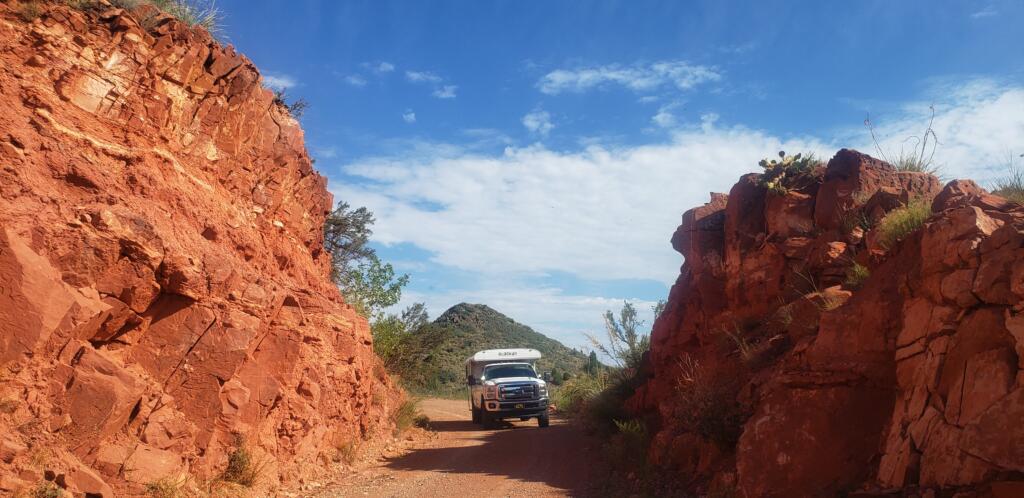How to Find Dispersed Camping Spots
We’re often asked how we find the best camping spots away from conventional public campgrounds. While we’ll be reviewing plenty of useful digital tools and technology tips, there’s really no substitute for a good old-fashioned conversation. We’ve discovered some of the best spots simply by chatting with game wardens or calling local ranger stations. Most are eager to share their knowledge of less trafficked areas, clarify local regulations, and provide updates on road conditions and weather forecasts. Local guides and outfitters are invaluable too, especially if you’re looking to incorporate hunting or fishing into your trip.

What is Dispersed Camping?
Dispersed camping, also known as boondocking, dry camping, or wild camping—is available within National Forests and BLM territories. It’s typically free and limited to 14-day stays within a 28-day period. These sites are often unmarked and are usually along secondary roads and can be tough to spot without some info. To minimize impact try and use existing sites, avoid leaving personal property unattended for more than 10 days (12 months in Alaska), and ensure no refuse or hazardous materials are left behind.
Relatively Obvious Dispersed Camping Setup Tips
Choose a previously used site to lessen environmental impact and opt for areas with good natural drainage to prevent soggy conditions. Be mindful of any fire restrictions, and pack out all garbage, including collected wood. To maintain the wilderness experience, avoid camping in meadows or directly on trails and keep your campsite discreet. Always camp on durable surfaces such as bare soil and stay at least 200 feet from any water sources to help prevent erosion and contamination.
Digital Resources For Dispersed Camping
Finding a great spot is made easy with a host of digital platforms tailored for campers. From comprehensive apps to detailed websites, these tools offer extensive coverage on not only dispersed campsites but also essential resources such as gas stations and water refill points. While most platforms are free or charge a minimal subscription fee and benefit from regularly updated, crowd-sourced content offering diverse insights, it’s important to critically assess this user-generated information. Remember, someone else’s idea of a quality and safe campsite might not necessarily meet your standards.
Google Earth Pro
Google Earth Pro is an indispensable tool for campers, offering the ability to explore historical satellite images from various seasons—perfect for spotting potential campsites when fall or spring foliage is sparse. This feature lets you zoom in closely for a detailed view of terrain and access routes. Google Earth becomes an even more powerful tool when paired with Treeline Academy’s Toolkit Bundle, which offers features like US Forest Service data and BLM roads overlays, displaying color-coded road designations on national forest lands for easier route planning, and custom contour filtering to assess terrain with precision.
AllTrails Pro
A treasure trove of trails, AllTrails Pro is invaluable for backpackers and casual hikers alike. It offers a comprehensive look at user-generated trail data, showcasing where people have camped and shared their experiences. While it excels at cataloging beginner hikes, it’s less about crafting custom routes and more about providing a platform for users to explore and review established trails.
Caltopo
On the opposite end of the spectrum from AllTrails, Caltopo is an robust planning tool. It overlays topographical maps with satellite imagery to help you plot routes across varied landscapes, from hiking to skiing. The platform is interactive, allowing you to plan directly on high-resolution maps, turn your phone into a GPS with its mobile app, and even dive into GIS data manipulation for those who prefer a more hands-on mapping experience. Also, the map printing feature is really nice for when you just want to hold a map and not your phone when exploring.

Hillmap.com
Another great app for meticulous planners is Hillmap. This web-app compares various map types, like Google Maps and Caltopo, side by side and it’s a handy tool for analyzing terrain for elevation changes, planning routes, and even assessing avalanche risks. Much like Caltopo, users can create and print customizable maps for free from high-quality map layers.
Campendium
Campendium was founded by a group of dedicated Airstream owners and has grown into a vibrant online community where users actively contribute reviews and share new locations. The service is free, with the option to subscribe for an ad-free experience. Campendium is especially popular among truck camper owners, offering a wide array of dispersed camping sites. This platform is a favorite among those looking to explore new areas while relying on up-to-date feedback from a community of like-minded campers.

The Dyrt
The Dyrt offers both free and premium subscription options to cater to a range of campers. The platform is renowned for its detailed descriptions and extensive reviews, complemented by photographs of established campgrounds. While The Dyrt’s list of dispersed campsites is still expanding, it provides invaluable resources for campers, including the ability to download maps for offline use.
HipCamp
HipCamp offers an easy way to book private campsites, working a lot like an Airbnb for campers. With no annual fees or membership requirements, users can simply search for and book a site using the app or website, filtering by location and amenities. The platform hosts a variety of camping options, from luxurious glamping tents and cozy cabins to basic gravel parking pads. Particularly useful near National Parks where dispersed camping spots are limited, HipCamp provides an alternative to the often crowded public sites.
Harvest Hosts
Harvest Hosts allows you to camp on unique private properties across the country. For a fee, campers can stay at diverse sites such as vineyards, farms, and even museums, often with opportunities to engage in local activities like farm tours and wine tastings. These sites are ideal for Alaskan owners seeking scenic, tranquil settings for boondocking, with the added perk of many hosts sites being large enough to host small groups or gatherings.
As we tie this up
Remember: the best camping trips might start with a plan, but it’s the unexpected turns that make the memories. Whether you’re thumbing through a paper map or scrolling through digital guides, mix a little spontaneity with your prep. Chat up the community in forums or Facebook groups, load up your Alaskan Camper, and maybe just see where the road takes you. Here’s to finding new trails, making new friends, and adding some unexpected stories to your outdoor adventures. Ready to roll out?
